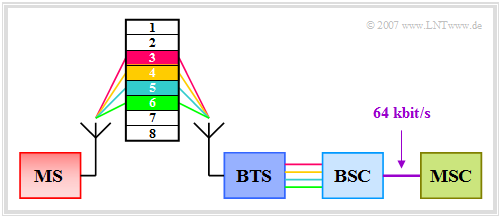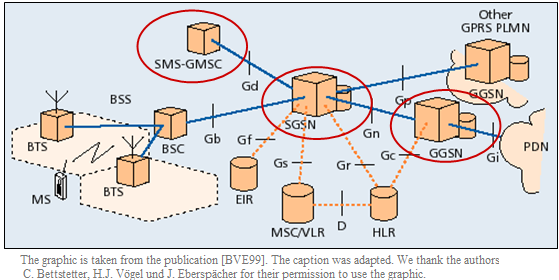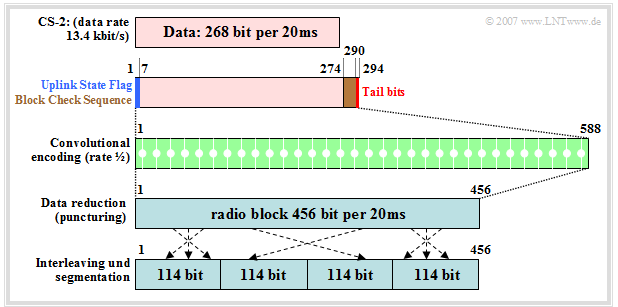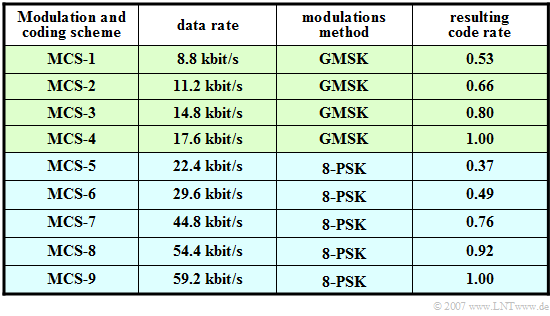Contents
The different phases of the GSM standardization
GSM was originally designed and developed as a pan-European mobile communications network, primarily for telephone calls and fax. Data transmission at a constant low data rate was secondary. The GSM standard was further developed in »various phases« after its presentation. The $\rm GSM$ system described so far in the third main chapter is limited to the first two phases.
⇒ The »phase 1« included only basic teleservices and a few additional services that could be offered on a mandatory basis by all network operators at that time when GSM was launched in 1991.
⇒ The standardization of the »phase 2« in the years from 1995 to 1997 already included the first further developments of the GSM standard. As a result, the additional services known from $\text{ISDN}$ were also gradually made available for GSM and supplemented by some new features, such as "call waiting" or "hold".
⇒ In the years 1997-2000, new data services with higher data rates were developed, which are allocated to the »phase 2+«. These new data services include:
- $\text{High Speed Circuit-Switched Data}$ $\rm (HSCSD)$,
- $\text{General Packet Radio Service}$ $\rm (GPRS)$,
- $\text{Enhanced Data Rates for GSM Evolution}$ $\rm (EDGE)$.
Note: Please do not confuse the terms "phase" and "generation":
- GSM is a second generation $\rm (2G)$ mobile communications system, independent of the standardization phase.
- The third generation $\rm (3G)$ includes $\text{UMTS}$. This standard enabled significantly higher data transmission rates than were possible with GSM.
- "Phase 2+" systems are in terms of performance between $\rm 2G$ and $\rm 2G$. That is why we speak of $\rm 2.5G$. The innovations of the "phase 2+" affect almost all aspects of GSM, from "radio transmission" to "call control".
High Speed Circuit–Switched Data (HSCSD)
The GSM data transmission standard »high speed circuit-switched data« $\rm (HSCSD)$, introduced in 1999, allowed the user data rate per connection to be increased from $9.6 \ \rm kbit/s$ to $14.4 \ \rm kbit/s$ when transmission conditions permitted.
- By bundling several adjacent time slots, the data rate could be increased even further.
- The data rate depends on how many channels the network operator provides for bundling or how many channels the HSCSD cell phone can process.
The graphic explains the principle of bundling multiple timeslots:
- Each of the eight physical channels $($time slots$)$ in a frame provides $14.4 \ \rm kbit/s$ for data communication. HSCSD enables channel bundling by combining multiple time slots, as is also used in ISDN. This is referred to as "multi-slot capability".
- Connecting all eight channels together would thus result in $\rm 115.2 \ kbit/s$. But since the connection between the base station controller $\rm (BSC)$ and the mobile switching center $\rm (MSC)$ is limited to $64 \ \rm kbit/s$, one is limited to bundling four time slots, resulting in a maximum transmission rate of $57.6 \ \rm kbit/s$ .
- An advantage of HSCSD technology over packet-switched GPRS $($next section$)$ is the circuit–switched data transmission. This is particularly advantageous for applications with uniform bandwidth, since here the channel does not have to be shared with anyone. Examples include video and image transmission.
- However, the higher transmission costs due to the occupancy of multiple channels are disadvantageous. These channels are therefore no longer available to other users. So in a radio cell with high channel utilization, it can happen that the bundling of multiple channels is prevented by the network operator.
General Packet Radio Service (GPRS)
With the GSM extension »general packet radio service« $\rm (GPRS)$, packet-switched data transmission was made possible for the first time in 2000.
- GPRS supports a large number of protocols $($Internet Protocol, X.25, Datex-P, etc.$)$ and allows mobile subscribers to communicate with external data networks $($the internet or internal company intranets$)$.
- GPRS was an important intermediate step in the evolution of cellular mobile networks towards third generation and towards the mobile internet.
A GPRS user benefits from shorter access times and the higher data rate $($to $21.4 \ \rm kbit/s)$ compared
- to conventional GSM $(9.6 \ \rm kbit/s)$
- and HSCSD $(14.4 \ \rm kbit/s)$.
⇒ With GPRS, the charges are not based on the connection duration, but on the actual amount of data transferred. Therefore, a radio channel does not have to be permanently reserved for a user $($as is the case with HSCSD$)$.
To introduce GPRS, some modifications and additions to the GSM network were necessary, as shown in the graph "GPRS System Architecture" from [BVE99][1]:
- Blue lines describe payload and signaling data.
- The orange dotted connections denote signaling data.
- $\rm Gb$, $\rm Gc$, $\rm Gd$, ... indicate interfaces of GPRS.
⇒ To integrate GPRS into the existing GSM system architecture, a new class of network nodes has to be added.
The additional GPRS components $($highlighted by red circles in the diagram$)$ are explained here only in bullet points:
- The »GPRS Support Nodes« $\rm (GSN)$ are responsible for the transmission and traffic routing of data packets between the mobile stations and the external packet-switched data networks. Here, a distinction is made between SGSN and GGSN, which communicate with each other via an IP-based GPRS backbone network.
- The »Serving GPRS Support Node« $\rm (SGSN)$ is responsible for mobility management and performs a similar function for packet data services as the »Mobile Switching Center« $\rm (MSC)$ does for connection-oriented speech signals.
- The »Gateway GPRS Support Node« $\rm (GGSN)$ is the interface to foreign packet-oriented data networks. It converts the GPRS packets coming from the SGSN into the appropriate protocol $($IP, X.25, ...$)$ and sends them out to the »Packet Data Network« $\rm (PDN)$.
GPRS air interface
When a GPRS cell phone is switched on, it first performs the "cell selection" procedure by searching for a frequency channel with GPRS data.
If such a channel has been found, then depending on the cell phone class, the cell phone must be manually set to GPRS services or it can automatically and dynamically switch between GPRS and GSM. A distinction is made between:
- Class $\rm A$ devices can handle GPRS data services and GSM transmission services simultaneously; channel resources are monitored in parallel in a packet-switched and circuit-switched manner.
- In class $\rm B$ the signaling channels of GSM and GPRS are monitored simultaneously as long as no service is switched through. However, parallel GSM/GPRS operation is not possible.
- In class $\rm C$ the subscriber must decide beforehand whether to use the mobile for GSM or GPRS, since signaling channels can no longer be monitored simultaneously.
⇒ To be able to switch the GSM radio interface to packet-oriented GPRS operation, the logical channels had to be extended. Logical GPRS channels can be recognized by a preceding "$\rm P$", which indicates the packet-oriented operating mode. Almost for all logical GSM channels there is the corresponding GPRS equivalent:
- The "Packet Data Traffic Channel" $\rm (PDTCH)$ is used in GPRS as »traffic channel« for user data transfer. The corresponding GSM channel is called $\rm TCH$.
- The »signaling channels« are divided as in GSM into
- the "Packet Broadcast Control Channel" $\rm (PBCCH)$,
- the "'Packet Common Control Channel" $\rm (PCCCH)$,
- the "Packet Dedicated Control Channel" $\rm (PDCCH)$.
⇒ GPRS allows subscribers to exchange data with public data networks and uses $($like GSM$)$ GMSK modulation and the FDMA/TDMA combination with eight time slots per TDMA frame. The differences are as follows:
- In the GSM standard, each active mobile station is assigned exactly one time slot of a TDMA frame. This physical channel is reserved for the mobile station for the entire duration of a call, both in uplink and downlink.
- In GPRS, up to eight time slots can be combined for rate enhancement. In addition, uplink and downlink are allocated separately. The physical channels are reserved only for the duration of the transmission of data packets and then released again.
GPRS channel coding
In contrast to conventional GSM $($with data rate $9.6 \ \rm kbit/s)$ four possible "coding schemes" are defined for GPRS, which can be used depending on the reception quality:
- Coding scheme 1 $\text{(CS – 1})$ with $9.05\ \rm kbit/s$ $($181 bits per 20 ms$)$,
- Coding scheme 2 $\text{(CS – 2})$ with $13.4\ \rm kbit/s$ $($268 bits per 20 ms$)$,
- Coding scheme 3 $\text{(CS – 3})$ with $15.6\ \rm kbit/s$ $($312 bits per 20 ms$)$,
- Coding scheme 4 $\text{(CS – 4})$ with $21.4\ \rm kbit/s$ $($428 bits per 20 ms$)$.
The smallest possible data rate is thus $9.05\ \rm kbit/s$ $($only one time slot$)$, the maximum $171.2\ \rm kbit/s$ $($eight time slots$)$. However, this theoretical speed was not achieved in practice, since most GPRS phones only support in 2007 a maximum net data rate of $13.4\ \rm kbit/s$ $\text{(CS – 2})$. The graphic refer to this combination:
- The $268$ information bits are first supplemented by six precoded bits of the "Uplink State Flag" $\rm (USF)$, $16$ parity bits of the "Block Check Sequence" $\rm (BCS)$ and four tail bits $(0000)$. The latter are necessary for the termination of the convolutional codes.
- For channel coding, the rate $1/2$ convolutional code known from GSM is used. By this the $294$ bits are doubled to $588$ bits and thus sufficiently protected against transmission errors.
- $132$ of these $588$ bits were punctured, so that finally a code word of length $456$ bits results $($bit rate $22.8 \ \rm kbit/s)$. This gives a resulting code rate $($from convolutional encoders including puncturing$)$ of $294/456 ≈ 65\%$.
- After channel coding, the code words are fed to a block interleaver of depth $4$. The interleaving scheme is identical for all four coding schemes.
Enhanced Data Rates for GSM Evolution
The last GSM extension »Enhanced data rates for GSM evolution« $\rm (EDGE)$ with the aim to increase the data transmission rate in GSM networks uses beside "Gaussian Minimum Shift Keying" $\rm (GMSK)$ as additional modulation method "eight-level phase shift keying" $\text{(8-PSK)}$:
- Then, there are eight different symbols $($with GMSK only two$)$, distinguished by different phase positions at multiples of $45^\circ$.
- This means: Three data bits can be transmitted with each symbol, increasing the data rate by a factor of $3$ compared to GPRS.
With this definition:
- $\text{HSCSD}$ becomes "Enhanced Circuit Switched Data" $\text{(E-CSD)}$ and
- $\text{GPRS}$ becomes "enhanced GPRS" $\text{(E-GPRS)}$.
The graph shows the "normal burst" of "EDGE" resp. "E-GPRS". One can see the following differences to the "GSM Normal Burst":
- The EDGE normal burst consists of $468.75$ bits instead of $156.25$ bits in GSM, from which the tripling of the data rate can be seen.
- As with GSM, there are two "stealing flags". Tailbits, training sequence and guard period are each tripled. This leaves $57 \cdot 3 + 2 = 173$ bits for the data field.
- Thus, $346$ bits of the rate $1/2$ channel encoded data are transmitted in E-GPRS in one "Normal Burst" per $576.9\ \rm µ s$, which corresponds to a net data rate of $\approx 60 \ \rm kbit/s$ .
Modulation and Coding Schemes for E–GPRS
In E-GPRS, there are used nine operator-selectable "Modulation and Coding Schemes" $\rm (MCS)$ depending on the current modulation and channel coding. The table shows the possible schemes in E-GPRS. From this it can be seen:
- Like GSM/GPRS, the first four schemes use the GMSK modulation with one bit of information per channel use, while "8-PSK" is used in MCS-5, ... , MCS-9, and thus three bits per symbol are transmitted.
- The smaller the code rate, the greater the added redundancy and thus the data security. In particular, between MCS-4 $(R_{\rm C} = 1)$ and MCS-5 $(R_{\rm C} = 0.37)$ the code rate decreases significantly due to the more favorable modulation mode despite the higher net data rate.
- The most elaborate mode $($MCS-9$)$ offers a data rate of $59.2\ \rm kbit/s$ and allows the simultaneous occupation of eight time slots, which would mean a maximum net data rate of $473.6\ \rm kbit/s$. However, this mode $($with $R_{\rm C} = 1)$ is only applicable under extremely good conditions.
- With MCS-8 and seven time slots you can already reach $380.8 \ \rm kbit/s$ and you are thus in the range of the 3G mobile radio standard $\rm UMTS$, which currently offers $384 \ \rm kbit/s$.
- EDGE uses the same frequencies as GSM, which is why this technology was particularly interesting for operators with existing GSM infrastructure who did not acquire any of the more expensive UMTS licenses and still wanted to offer a sufficiently high data rate.
The UMTS system is described in detail in the following fourth main chapter.
Exercise for the chapter
Exercise 3.8: General Packet Radio Service
References
- ↑ Bettstetter, C.; Vögel, H.J.; Eberspächer, J.: GSM Phase 2+ General Packet Radio Service GPRS: Architecture, Protocols, and Air Interface. In: IEEE Communications Surveys & Tutorials, Vol. 2 (1999) No. 3, pp. 2-14.




